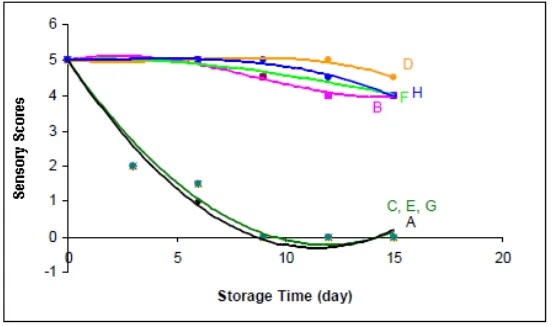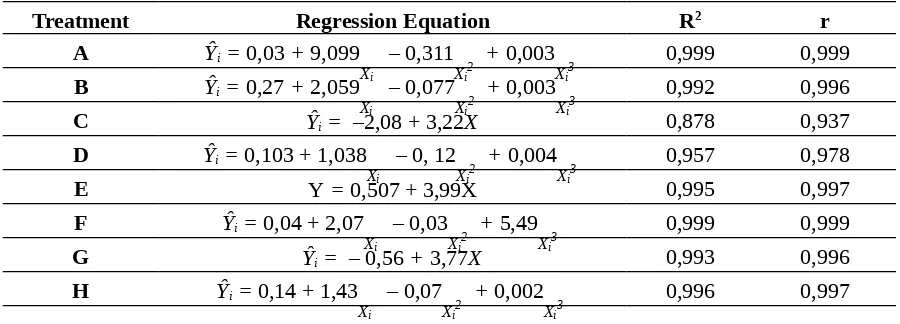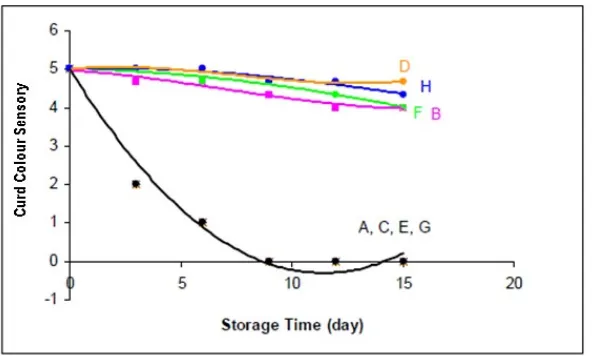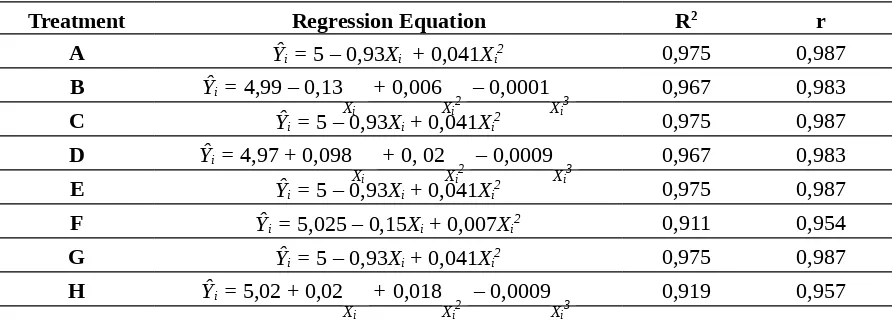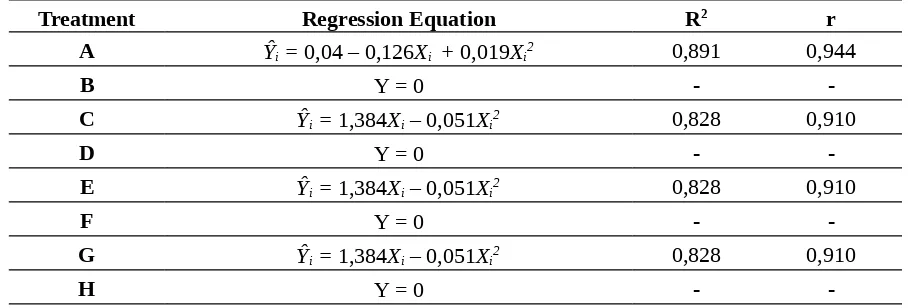The Development Of Post-harvest Field Technology
For Fresh Exportable Vegetables Produced In Indonesia
Nurpilihan Bafdal1; Carmencita Cahyadi1; Sumanti Moody1; Totok Pujianto1; Seok-In-Hong2; Dongman Kim2;
1Agriculture Industrial Technology - Universitas Padjadjaran, Sumedang 45363, Indonesia
2Korean Food Research Institute, South Korea
I. Abstract
In Indonesia fresh handling of vegetables is still carried out by traditional methods, without hardly any sorting or grading prior to marketing. Therefore, post-harvest loss reduction of vegetables, both quantity and quality loss must begin at the farm level. Although quality of fresh produce cannot be improved post-harvest handling, however it is necessary for extending shelf-life. The development of quantity and quality of production in order to obtain high added value, require the application of post-harvest technology.
The objective of this research is to assess of appropriate post-harvest technology of broccoli and cabbage at farm level and to develop of quantity and quality of production in order to obtain high added value.
packaging. 2). LPDE bag was best for cold storage of broccoli curds. 3). Low temperature storage gave not good for head surface color.
Keywords: post-harvest technology; appropriated post-harvest technology; discoloration
II. Introduction
In Indonesia fresh handling of vegetables is still carried out by traditional methods, without hardly any sorting or grading prior to marketing. Therefore, post-harvest loss reduction of vegetables, both quantity and quality loss, must begin at the farm level. Although quality of fresh produce cannot be improved by post-harvest handling however it is necessary for extending shelf-life.
Introducing appropriate post-harvest technology at the farm level require research on a) storage stability at ambient and low temperature and b) packing and packing methods of produce. For the moment research will be carried out on broccoli because since broccoli is the most highly priced cool-crop in Indonesia although it is not extensively grown.
Rukmana (1994) mentioned quality factors for broccoli consist of curd density; greenness, absence of blemish and curd diameters. Heads of broccoli must be entirely green and flower buds be completely closed to be desirable. A purplish cast to the surface is not all objection. However, yellowing or wilting is highly objectionable and indicates poor handling practices somewhere in market channel. Generally the large central heads are more desirable than the side shoots (Ryall and Lipton, 1972). Broccoli is grade into 4 size-grades, respectively :
a. Grade 1 : 30 cm curd diameter b. Grade 2 : 25 – 30 cm curd diameter c. Grade 3 : 20 – 25 cm curd diameter d. Grade 4 : 15 – 20 cm curd diameter.
The quality of the product can not be improved by post-harvest handling, but is necessary for extending shelf-life. Post-harvest handling covers the time span from product harvesting in the farm field until it reaches the urban consumer through the market (Tjahjadi, 2006).
produce is defined as the period from harvest to consumption that a food product remains safe and wholesome.
There was 5 methods post harvest handling of fresh produce such as broccoli, respectively : (1) Grading; (2) Packaging; (3) Pre-cooling; (4) Storage; and (5) Transportation.
Broccoli should be harvested when the curd is firm/compact, has attained maximum size and the flowers has not opened yet. Harvesting time is 50 – 60 days after planting depending on cultivar (Rukmana, 1994).
Harvesting should be done in the morning or in the afternoon. The curds are cut with a stem length of 25 cm and leaves left on the stem.
The shelf-life of broccoli is usually terminated by yellowing which detract from consumer acceptability. High temperature, low humidity and the presence of ethylene gas accelerate yellowing (Tan, 2005). Putting ice on top of broccoli in a polystyrene box will be beneficial if temperature and humidity control are poor. Ice is frequently used on broccoli for local markets and for export by air freight. Polyethylene boxes with ice topping are more expensive than waxed cartons with plastic liners. When temperature can be maintained effectively there is no need to use this method which has its disadvantages. When ice melts during storage and transpiration the melted water will aid the development of microbial infections, and rot the produce (Tan, 2005).
III. Materials And Methods
The experiment was carried out at the Food Process Engineering and the Post-Harvest Technology Laboratories of the Faculty of Agriculture Industrial Technology of The Padjadjaran University at Jatinangor from December 2006 up to January 2007.
Broccoli Brassica oleracea L. gp. Italica) harvested 2 months after planting, and possessing curds of 15 cm diameter, dark green in color and compact was used for the experiment. The packaging materials were low density polyethylene bags, polyethylene net, and carton boxes.
Equipments used for the experiment were stainless steel knives, O-Hauss balance, analytical balance, hairhygrometer, thermometer plastic, bag sealer, and a digital camera (Olympus).
A : without packaging, stored at ambient temperature (27 0 C ± 2 0 C)
B : without packaging, stored in cold storage (5 0 C ± 10 C)
C : packed in LDPE bag, stored at ambient temperature (27 0 C ± 2 0 C)
D : packed in LDPE bag, stored in cold storage (5 0 C ± 10 C)
E : packed in polypropylene net bag, stored at ambient temperature (27 0 C ± 2 0 C)
F : packed in polypropylene net bag, stored in cold storage (5 0 C ± 10 C)
G : packed in carton box, stored at ambient temperature (27 0 C ± 2 0 C)
H : packed in carton box, stored in cold storage (5 0 C ± 10 C)
The variables observed were sensory description using a sensory scoring standard, degree of decay (percentage of decay), weight loss i.e. 2 weeks for broccoli (Muchtadi, 1997), and surface color score based on CIE color measurement (Yam and Papadakis, 2004).
The sensory scoring standard for broccoli was prepared by storing sound curds at ambient temperature (27 0 C ± 2 0 C) for 48 hours. Observation and photographs of the
samples were made every 4 hours until yellowing of the curds. Variables measured were curd color, percentage of discoloration of curd surface either due to yellowing or disease (grey or black discoloration). Five pictures were chosen and assigned sensory scores ranging from 1 (Excellent) to 5 (Not fit for sale). Observation of samples were done at 2 day intervals, producing 14 photographs. Consequently 5 pictures were selected and assigned sensory scores ranging from 1 (Excellent) to 5 (No t fit for sale).
The packaging and storage temperature experiment on broccoli were done as follows: samples were sorted, trimmed and weighed. Each type of container was filled with 3 samples. The PE bags were divided into 3 sections by using a bag-sealer and in each compartment 1 sample was placed. Subsequently samples were stored at ambient temperature or in the cold storage room according to the treatments allotted. Broccoli was observed every 3 days for 2 weeks, while cabbage was observed at weekly intervals for 2 months.
IV. RESULT AND DISCUSSION
The sensory scoring standard for broccoli stored at ambient temperature (27 0 C ± 2 0 C)
for 56 hours is presented in Figure 1 as follow :
Score 5
Curd color: Green (+ +) with yellow blotches L* = 59.75
- Slight dark spotting at the curd edges
b* = 45.87 Discoloration:
- 5% green and 95% yellow , lots of dark spotting on the edges
Figure 1. Sensory scoring standard and description of scores for broccoli
4.2. Changes in Sensory Scores of Broccoli during Storage at AmbientTemperature and Cold Storage
Regression Curves between sensory scores and storage time for the packing and storage temperature treatments are shown in Figure 2, while the regression equations coefficients of determination and coefficients of correlation are presented in Table 1.
Figure 2. Regression curves of sensory scores of broccoli and storage time
Table 1 shows that all linear regression equations posses R values larger than 0.855, showing equations fit very well. Regression Curve for treatment D showed that after 15 days storage the sensory score of the broccoli sample was still excellent, i.e. no decline of sensory score occurred during storage. Sample D was packed in a sealed LDPE bag and stored at 5 0 C ± 10 C, so that besides the low storage temperature, inside the sealed bag a
modified atmosphere (high CO2 low O2 ) might have developed.
Treatment Regression Equation R2 r
Treatment A C E G, which were stored at ambient temperature, reached a sensory score of 2 after 3 days i.e. not acceptable anymore to be displayed for sale. Tan (2005) reported that shelf-life of broccoli at 20 0 C and 60 – 70% RH is only 1 – 2 days while at 4 0 C
shelf life is 2 – 6 weeks. In conclusion, packaging treatments respectively without packaging, LDPE bag, propylene-net-bag and carton box, without refrigeration, can not prolong shelf-life of broccoli if not stored at lo w temperature.
Treatment B, D, F and H, which were stored at 50 C, still attained sensory scores
ranging from 4 to 5 after 15 days, showing low temperature storage irrespective of packaging, was able to keep the broccoli samples in excellent condition. Treatment D as previously discussed gave the best results, probably due to the modified atmosphere generated within the sealed LDPE bag. Up to 6 days storage hardly any difference in sensory scores was observed, showing all 4 packaging treatments were equally good.
4.3. Weight Loss of Broccoli
Figure 3. Regression Curves of Weight Loss of Broccoli against Storage Time
Table 2. Regression Equations of Weight Loss of Broccoli against Storage Time and Their Coefficients of Determination and Coefficients of Correlation
The ambient temperature weight loss was highest in treatment A, i.e. without packaging, followed by treatment E (packed in propylene net bag), G (packed in carton box), and C (packed in LDPE bag). Weight loss after 15 days storage was about 75 % in treatment A and 45% in treatment C.
At 50 C ± 10 C weight loss of treatments F (PP-net bag) and B (without packaging)
Protection of the packaging materials against weight loss was quit significant, PP net-bag equals no packaging, while the carton-box gave intermediate values of weight loss (10% weight loss in 2 weeks), while the LDPE bag gave the best protection (2% weight loss in 2 weeks). The no packaging and net-bag probably provides too much air movement during storage, causing larger losses. As Boyette (2006) said, mesh bags are now abandoned due to the minimal protection it provides against rough handling and the larger wilting losses. The carton box is light-weight and pro vides sufficient protection, while the LDPE bag provides good protection against moisture losses, is also light-weight but it does not give sufficient protection against rough handling.
4.4. Curd Color
Curd color was evaluated using the same sensory standard as presented in Figure 6 Regression curves between curd co lour sensory scores against storage time are presented in Figure 4 and Table 3. R2 for the samples stored at ambient temperature and in
cold storage ranged from 0.911 to 0.975 showing a very good fit.
Figure 4. Regression curves of curd color sensory scores of broccoli against storage time
Curds stored at 50 C ± 2 0 C still obtained color scores between 4 and 5 after the 15 day
Table 3. Regression Equations of Curd Color Sensory Scores of Broccoli against Storage Time and Their Coefficients of Determination and Coefficients of Correlation
Treatment Regression Equation R2 r (1984). Color change starts when flowers begin to open and turn yellow (Salunkhe and Desai, 1984), this occurs within 3 days at room temperature. Yellowing it self is related to ethylene production by the broccoli, although refrigeration could reduce ethylene production considerably. Treatment D was best, partly because of the modified atmosphere generation within the LDPE bag.
4.5. Curd Decay
Curd decay regression curves and regression equations at ambient temperature and cold storage are presented in Figure 5 and Table 4.
Table 4. Regression equations of curd decay scores of broccoli against storage time and their coefficients of determination and coefficients of correlation
Treatment Regression Equation R2 r
A Ŷi = 0,04 – 0,126Xi + 0,019Xi2 0,891 0,944
B Y = 0 -
-C Ŷi = 1,384Xi– 0,051Xi2 0,828 0,910
D Y = 0 -
-E Ŷi = 1,384Xi– 0,051Xi2 0,828 0,910
F Y = 0 -
-G Ŷi = 1,384Xi– 0,051Xi2 0,828 0,910
H Y = 0 -
-Table 4 shows that samples stored at room temperature have R values less than 0,80 except for treatment A, thus showing less suitable fit Decay was highest in treatments C, G, E (11%) i.e. treatments packed in various types of packages and stored at ambient temperature. Treatment A (without packaging + ambient temperature storage) showed decay after day 5 and culminated at day 15 (about 2%). The warm ambient temperature was suitable for mold growth and was also aggravated by packaging, because packaging causes RH within the package to increase. Mold usually requires a temperature of 25 – 50 0 C and RH of 70 – 75% for growth.
Cold storage (treatment B, D, F, H) did not show mold growth at all during the 15 day storage, either on curds stored without packaging or in the various types of packages. This shows that mold growth is more affected by storage temperature than packaging.
V. Conclusions
1. Low storage temperature in broccoli storage is more important than type of packaging in maintaining sensory characteristics of the curd and reducing weight loss as well as decay scores.
2. LDPE bag was best for cold storage of broccoli curds.
3. In cabbage storage, low temperature gave better retention of sensory characteristics and reduces weight loss as well as decay scores, but for head surface colour the results were inconsistent.
VI. References
Kim, D. , 2006, Post-Harvest Technology in Korea. Paper Presented at the One Day International Seminar Post-Harvest Losses of Cole Crops (Brassica vegetables) Causes and Solutions November, 6 th , 2006. , Bandung, Indonesia.
Rukmana, R. , 1994, Budidaya Kubis Bunga dan Broccoli. Penerbit Kanisius, Yogyakarta, Indonesia.
Tan, S.C. , 2005, Post-harvest Handling of Brassica Vegetables Department Agriculture Western – Australia, www.agric.wa.gov.au , Accesed on September, 9 th , 2006.
Tjahjadi, C. , 2006, Post-Harvest Handling of Cole Crops (crucifers) in West Java. Paper Presented at the One Day International Seminar Post-Harvest Losses of Cole Crops (Brassica vegetables) Causes and Solutions November, 6 th , 2006. , Bandung,
